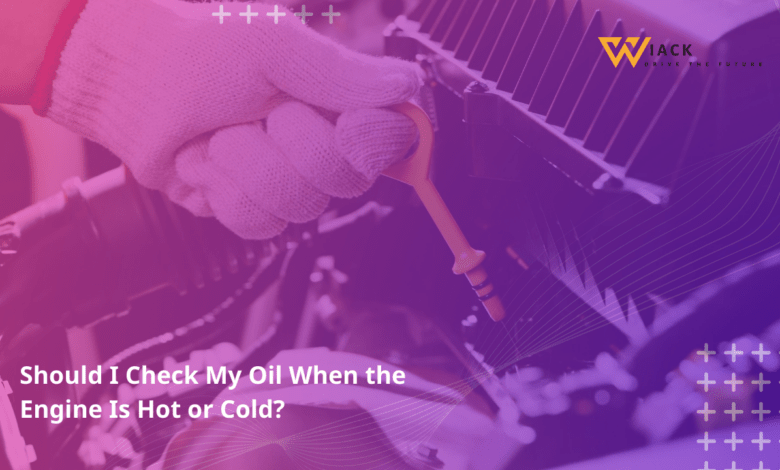Should I Check My Oil When the Engine Is Hot or Cold?

Did you know that according to a recent survey, over 30% of drivers don’t know how to properly check their engine oil? This surprising statistic highlights the importance of understanding the basics of vehicle maintenance, including when and how to check your engine oil. Whether you’re a seasoned driver or new to car ownership, knowing the answer to the question “Should I check my oil when the engine is hot or cold?” is crucial for maintaining your vehicle’s health and longevity.
The Importance of Checking Your Oil
Engine oil is the lifeblood of your vehicle. It lubricates moving parts, reduces friction, and helps dissipate heat from the engine. Regular oil level inspection is a critical part of car maintenance procedures that every driver should be familiar with.
Why Is Checking Your Oil Level Important?
Checking your oil level regularly serves several important purposes:
- Prevents engine damage: Adequate oil levels ensure proper lubrication, preventing excessive wear on engine components.
- Identifies potential issues: Changes in oil level or appearance can indicate problems like leaks or excessive oil consumption.
- Improves fuel efficiency: Proper oil levels help your engine run more efficiently, potentially saving you money on fuel.
- Extends engine life: Regular oil checks and maintenance can significantly extend the life of your engine.
Engine oil maintenance tips like regular checks can save you from costly repairs down the road. By making oil checks a part of your routine, you’re taking a proactive approach to vehicle maintenance.
What Happens When You Don’t Check Your Oil?
Neglecting to check your oil can lead to serious consequences:
- Engine overheating: Low oil levels can cause your engine to overheat, potentially leading to severe damage.
- Increased friction: Insufficient oil means more friction between moving parts, accelerating wear and tear.
- Reduced performance: Your engine may not run as smoothly or efficiently with low or dirty oil.
- Catastrophic engine failure: In extreme cases, running an engine without sufficient oil can lead to complete engine failure.
Remember, prevention is always better than cure when it comes to engine care. Regular oil checks are a simple yet effective way to prevent these issues.
When to Check Your Oil
Now that we understand the importance of checking oil, let’s address the main question: Should I check my oil when the engine is hot or cold? The answer isn’t as straightforward as you might think, as there are advantages and disadvantages to both methods.
Checking Oil When the Engine Is Cold
Many car care professionals recommend checking your oil when the engine is cold, or at least cool enough to touch safely.
Advantages of Checking Oil When Cold
- Safety: There’s no risk of burns from hot engine components.
- Accuracy: All the oil has drained back into the oil pan, giving a more accurate reading.
- Convenience: You can check the oil first thing in the morning before starting your car.
Disadvantages of Checking Oil When Cold
- Potential inaccuracy: In very cold weather, oil can thicken and cling to engine parts, potentially giving a lower reading.
- Missed issues: Some problems, like oil thinning due to fuel contamination, might not be apparent when the engine is cold.
Checking Oil When the Engine Is Warm
Some mechanics and vehicle maintenance guides suggest checking oil when the engine is warm, but not hot.
Advantages of Checking Oil When Warm
- Realistic conditions: You get a reading that reflects normal operating conditions.
- Easier to spot issues: Problems like oil thinning or contamination may be more apparent.
- More accurate in cold weather: Warm oil flows more freely, giving a more accurate reading in cold climates.
Disadvantages of Checking Oil When Warm
- Safety concerns: There’s a risk of burns from hot engine components.
- Potential inaccuracy: If checked immediately after turning off the engine, some oil may still be in the upper engine parts.
- Inconvenience: You need to wait for the engine to cool down slightly before checking.
How to Check Your Oil
Regardless of whether you choose to check your oil when the engine is hot or cold, the process remains largely the same. Here’s a step-by-step guide to proper oil level check:
Locate the Dipstick
First, you need to find the oil dipstick. In most cars, it’s located near the front of the engine and has a brightly colored handle (often yellow or orange) marked with an oil can symbol.
Remove and Clean the Dipstick
Pull the dipstick out completely. You’ll see that the end is coated with oil. Wipe this oil off with a clean, lint-free rag or paper towel. This step is crucial for accurate dipstick measurement.
Reinsert the Dipstick
Once clean, fully reinsert the dipstick into its tube. Make sure it’s pushed all the way in for an accurate reading.
Read the Oil Level
Pull the dipstick out again and look at the end. You’ll see oil clinging to the dipstick. There are usually two marks or holes on the dipstick indicating the proper oil level range.
Interpret the Oil Level
If the oil is between the two marks, your oil level is good. If it’s below the lower mark, you need to add oil. If it’s above the upper mark, you may have too much oil, which can also cause problems.
Remember, engine oil levels can vary slightly between hot and cold readings, so consistency in your checking method is key.
Factors That Affect Oil Level Readings
Several factors can influence your oil level readings, making it important to understand these variables for accurate oil check temperature assessments.
Engine Temperature
As we’ve discussed, whether you’re checking oil when hot or checking oil when cold can affect your reading. Hot oil expands and may give a slightly higher reading, while cold oil contracts and may read lower.
Oil Type
Different types of oil behave differently at various temperatures. Synthetic oils, for example, tend to maintain their viscosity better across a range of temperatures compared to conventional oils.
Ambient Temperature
The outside temperature can also affect your readings, especially in extreme conditions. In very cold weather, oil can thicken and cling to engine parts, potentially giving a lower reading when the engine is cold.
What to Do If Your Oil Level Is Low
If you find that your oil level is low, don’t panic. Here’s what you should do:
Add Oil
If the level is just slightly low, you can add oil yourself. Use a funnel to avoid spills and add small amounts at a time, rechecking the level after each addition.
Consult Your Owner’s Manual
Your car’s manual will specify the correct type and grade of oil to use. Using the wrong type can potentially harm your engine, so always follow the manufacturer’s recommendations.
Visit a Mechanic
If you’re consistently low on oil or if you’re not comfortable adding oil yourself, visit a professional. Auto repair shops and oil change services can help ensure your car is properly maintained.
Conclusion
The Best Time to Check Your Oil
So, what’s the verdict on the best time to check engine oil? The most accurate answer is: it depends on your specific vehicle and circumstances. However, here are some general guidelines:
- For most vehicles, checking the oil when the engine is warm but not hot (about 5-10 minutes after shutting off) provides a good balance of safety and accuracy.
- If you’re checking first thing in the morning or in very cold weather, allow the engine to run for a few minutes to warm up the oil before checking.
- Always follow the recommendations in your vehicle’s owner’s manual, as some manufacturers have specific instructions for oil checks.
Regular Maintenance is Key
Regardless of whether you choose to check your oil hot or cold, the most important thing is to check it regularly. Make oil checks a part of your routine vehicle maintenance tips, along with other essential tasks like checking tire pressure and fluid levels.
Remember, your car’s engine is a complex machine, and proper maintenance is crucial for its longevity and performance. By understanding and implementing these engine oil maintenance tips, you’re taking an important step in caring for your vehicle.
Whether you’re a DIY enthusiast or prefer to leave maintenance to the professionals, knowing how to properly check your oil empowers you to take better care of your vehicle. And if you’re ever in doubt, don’t hesitate to consult with engine care experts or join car maintenance forums for advice.
By staying proactive about your car’s health, you’ll not only save money on potential repairs but also enjoy a smoother, more reliable driving experience. So next time you pop the hood, remember these tips and check that oil with confidence!
Get the latest car news, reviews, and prices at Wiack.com. Your one-stop destination for all things automotive.




